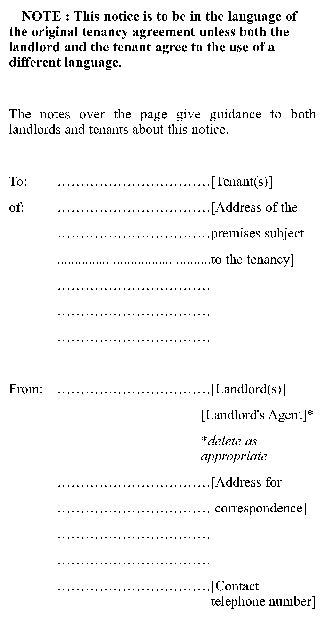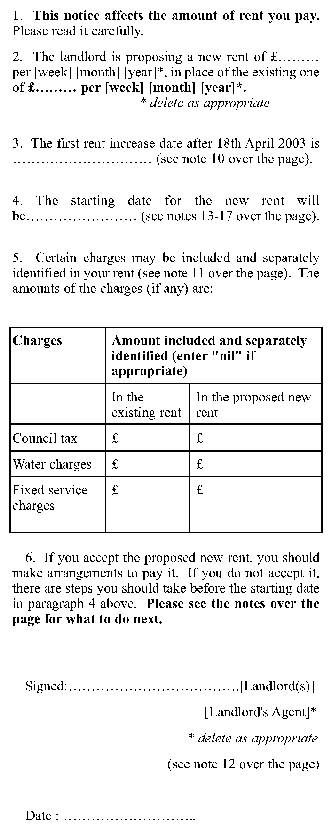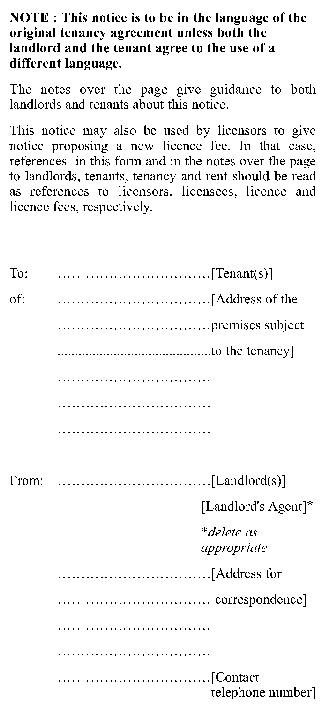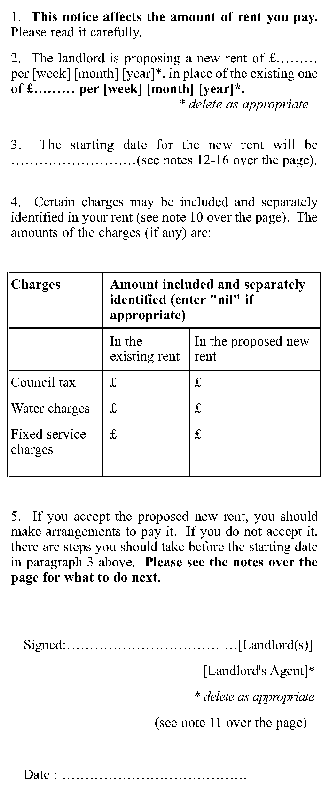2003 No. 307 (W.46)
The Assured Tenancies and Agricultural Occupancies (Forms) (Amendment) (Wales) Regulations 2003
Made
Coming into force in accordance with Regulation 1(2)
Name, commencement and applicationI11
1
These Regulations are called the Assured Tenancies and Agricultural Occupancies (Forms) (Amendment) (Wales) Regulations 2003.
2
These Regulations come into force as follows —
a
Regulations 1 and 2 on 18th February 2003; and
b
Regulation 3 on 18th April 2003.
3
These Regulations apply only in relation to premises situated in Wales.
Amendment of Prescribed FormsI22
1
The Assured Tenancies and Agricultural Occupancies (Forms) Regulations 19973 (“the 1997 Regulations”) are amended as follows.
2
After regulation 3(da) of the 1997 Regulations insert the following two new sub-paragraphs —
db
for a notice under section 13(2) proposing a new rent for an assured tenancy of premises situated in Wales, Form No. 4D;
dc
for a notice under section 13(2) proposing a new rent or licence fee for an assured agricultural occupancy of premises situated in Wales, Form No. 4E;
3
In the Schedule to the 1997 Regulations, after Form No. 4C insert the forms in the Schedule to these Regulations.
Revocation and savingI33
1
Form No. 4 set out in the Schedule to the 1997 Regulations is hereby revoked.
2
Nothing in paragraph (1) above affects the validity of a notice under section 13(2) of the Housing Act 1988 (notice proposing a new rent) served before the coming into force of this regulation if, at the date of service of the notice, the notice was in Form No. 4 or in a form substantially to the same effect.
Signed on behalf of the National Assembly for Wales under section 66(1) of the Government of Wales Act 19984
SCHEDULEFORMS PRESCRIBED FOR THE PURPOSES OF SECTION 13(2) OF THE HOUSING ACT 1988
Landlord’s Notice proposing a new rent under an Assured Periodic Tenancy of premises situated in Wales.
I4
Please read these notes carefully.
Guidance notes for tenants
What you must do now
I51
This notice proposes that you should pay a new rent from the date specified in paragraph 4 of the notice. If you are in any doubt or need advice about any aspect of this notice, you should immediately either discuss it with your landlord or take it to a citizens' advice bureau, a housing advice centre, a law centre or a solicitor.
I62
If you accept the proposed new rent, please make arrangements to pay it. If you pay by standing order through your bank, you should inform them that the amount has changed. You should also notify your Housing Benefit office, if you are claiming benefit. If you are worried that you might not be able to pay your rent, you should seek advice from a citizens' advice bureau or housing advice centre.
I73
If you do not accept the proposed new rent, and do not wish to discuss it with your landlord, you can refer this notice to your local rent assessment committee. You must do this before the starting date of the proposed new rent in paragraph 4 of the notice. You should notify your landlord that you are doing so, otherwise he or she may assume that you have agreed to pay the proposed new rent.
I84
To refer this notice to the local rent assessment committee, you must use the form Application referring a notice proposing a new rent under an Assured Periodic Tenancy or Agricultural Occupancy to a Rent Assessment Committee. You can obtain this from a rent assessment panel, housing advice centre or legal stationer (details can be found in the telephone directory).
I95
The rent assessment committee will consider your application and decide what the maximum rent for your home should be. In setting a rent, the committee must decide what rent the landlord could reasonably expect for the property if it were let on the open market under a new tenancy on the same terms. The committee may therefore set a rent that is higher, lower or the same as the proposed new rent.
Guidance notes for landlords on how to complete the notice
I106
You can complete this notice in ink or arrange for it to be printed.
I117
This notice should be used when proposing a new rent under an assured periodic tenancy (including an assured shorthold periodic tenancy) of premises situated in Wales. There is a different notice (Form 4E — Landlord’s or Licensor’s Notice proposing a new rent or licence fee under an Assured Agricultural Occupancy of premises situated in Wales) for proposing a new rent or licence fee for an assured agricultural occupancy of premises situated in Wales.
I128
Do not use this notice if the tenancy agreement contains a term allowing rent increases, or there is some other basis such as a separate agreement with the tenant for raising the rent. Any provision you rely on needs to be binding on the tenant. Legal advice should be sought if there is any doubt on this score.
I139
You need to use a different form to propose a rent increase for a statutory periodic tenancy (the first exception mentioned in note 16) if you are seeking to adjust rent solely because of a proposed change of terms under section 6(2) of the Housing Act 1988. Seek legal advice if you think this may apply to you. You can obtain the form headed Notice proposing different terms for a Statutory Periodic Tenancy from a rent assessment panel or a legal stationer.
I1410
Unless the tenancy is a new one, or one of the exceptions mentioned in note 16 applies, you must insert in paragraph 3 of the notice the first date after 18th April 2003 on which rent was increased under this statutory notice procedure. That date determines the date that you can specify in paragraph 4 of the notice. See also note 15.
I1511
You should enter in each of the boxes in the second and third columns of the table in paragraph 5 either “Nil” or the amount of the existing or proposed charge. You should only enter amounts for council tax and water rates where the tenant does not pay these charges directly. You should only enter fixed service charges which are payable by the tenant in accordance with a term or condition which specifies that these charges will be included in the rent for the tenancy. Only enter an amount for service charges where the tenant has agreed to pay a fixed sum. Do not include in the table any variable service charge, i.e. a service charge within the meaning of section 18 of the Landlord and Tenant Act 1985, where the whole or part of the sum payable by the tenant varies or may vary according to costs.
I1612
You or your agent (someone acting on your behalf) must sign and date this notice. If there are joint landlords, each landlord must sign unless one signs on behalf of the rest with their agreement. The signature does not have to be hand-written if, for instance, the form is being printed or if you wish to use a laser or autosignature.
When the proposed new rent can start
I1713
The date in paragraph 4 of the notice must comply with the three requirements of section 13(2) of the Housing Act 1988, as amended by the Regulatory Reform (Assured Periodic Tenancies) (Rent Increases) Order 2003.
I1814
The first requirement, which applies in all cases, is that a minimum period of notice must be given before the proposed new rent can take effect. That period is:
one month for a tenancy which is monthly or for a lesser period, for instance weekly or fortnightly;
six months for yearly tenancy;
in all other cases, a period equal to the length of the period of the tenancy — for example, three months in the case of a quarterly tenancy.
I1915
The second requirement applies in most cases (but see note 16 for two exceptions):
a
the starting date for the proposed new rent must not be earlier than 52 weeks after the date on which the rent was last increased using this statutory notice procedure or, if the tenancy is new, the date on which it started, unless
b
that would result in an increase date falling one week or more before the anniversary of the date in paragraph 3 of the notice, in which case the starting date must not be earlier than 53 weeks from the date on which the rent was last increased.
This allows rent increases to take effect on a fixed day each year where the period of a tenancy is less than one month. For example, the rent for a weekly tenancy could be increased on, say, the first Monday in April. Where the period of a tenancy is monthly, quarterly, six monthly or yearly, rent increases can take effect on a fixed date, for example, 1st April.
I2016
The two exceptions to the second requirement, which apply where a statutory tenancy has followed on from an earlier tenancy, are:
where the tenancy was originally for a fixed term (for instance, 6 months), but continues on a periodic basis (for instance, monthly) after the term ends; and
where the tenancy came into existence on the death of the previous tenant who had a regulated tenancy under the Rent Act 1977.
In these cases the landlord may propose a new rent at once. However, the first and third requirements referred to in notes 14 and 17 must still be observed.
I2117
The third requirement, which applies in all cases, is that the proposed new rent must start at the beginning of a period of the tenancy. For instance, if the tenancy is monthly, and started on the 20th of the month, rent will be payable on that day of the month, and a new rent must begin then, not on any other day of the month. If the tenancy is weekly, and started, for instance, on a Monday, the new rent must begin on a Monday.
Landlord’s or Licensor’s Notice proposing a new rent or licence fee under an Assured Agricultural Occupancy of premises situated in Wales.
I22
Please read these notes carefully.
Guidance notes for agricultural occupants
What you must do now
I231
This notice proposes that you should pay a new rent from the date specified in paragraph 3 of the notice. If you are in any doubt or need advice about any aspect of this notice, you should immediately either discuss it with your landlord or take it to a citizens' advice bureau, a housing advice centre, a law centre or a solicitor.
I242
If you accept the proposed new rent, please make arrangements to pay it. If you pay by standing order through your bank, you should inform them that the amount has changed. You should also notify your Housing Benefit office, if you are claiming benefit. If you are worried that you might not be able to pay your rent, you should seek advice from a citizens' advice bureau or housing advice centre.
I253
If you do not accept the proposed new rent, and do not wish to discuss it with your landlord, you can refer the notice to your local rent assessment committee. You must do this before the starting date of the proposed new rent in paragraph 3 of the notice. You should notify your landlord that you are doing so, otherwise he or she may assume that you have agreed to pay the proposed new rent.
I264
To refer this notice to the local rent assessment committee, you must use the form Application referring a notice proposing a new rent under an Assured Periodic Tenancy or Agricultural Occupancy to a Rent Assessment Committee. You can obtain this from a rent assessment panel, housing advice centre or legal stationer (details can be found in the telephone directory).
I275
The rent assessment committee will consider your application and decide what the maximum rent for your home should be. In setting a rent, the committee must decide what rent the landlord could reasonably expect for the property if it were let on the open market under a new tenancy on the same terms. The committee may therefore set a rent that is higher, lower or the same as the proposed new rent.
Guidance notes for landlords on how to complete the notice
I286
You can complete this notice in ink or arrange for it to be printed.
I297
This notice should be used when proposing a new rent or licence fee for an assured agricultural occupancy of premises situated in Wales. There is a different notice (Form 4D — Landlord’s Notice proposing a new rent under an Assured Periodic Tenancy of premises situated in Wales) for proposing a new rent for an assured periodic tenancy (including an assured shorthold periodic tenancy) of premises situated in Wales.
I308
Do not use this notice if the tenancy agreement contains a term allowing rent increases, or there is some other basis such as a separate agreement with the tenant for raising the rent. Any provision you rely on needs to be binding on the tenant. Legal advice should be sought if there is any doubt on this score.
I319
You need to use a different form to propose a rent increase for a statutory periodic tenancy (the first exception mentioned in note 15) if you are seeking to adjust rent solely because of a proposed change of terms under section 6(2) of the Housing Act 1988. Seek legal advice if you think this may apply to you. You can obtain the form headed Notice proposing different terms for a Statutory Periodic Tenancy from a rent assessment panel or a legal stationer.
I3210
You should enter in each of the boxes in the second and third columns of the table in paragraph 4 either “Nil” or the amount of the existing or proposed charge. You should only enter amounts for council tax and water rates where the tenant does not pay these charges directly. You should only enter fixed service charges which are payable by the tenant in accordance with a term or condition which specifies that these charges will be included in the rent for the tenancy. Only enter an amount for service charges where the tenant has agreed to pay a fixed sum. Do not include in the table any variable service charge, i.e. a service charge within the meaning of section 18 of the Landlord and Tenant Act 1985, where the whole or part of the sum payable by the tenant varies or may vary according to costs.
I3311
You or your agent (someone acting on your behalf) must sign and date this notice. If there are joint landlords, each landlord must sign unless one signs on behalf of the rest with their agreement. The signature does not have to be hand-written if, for instance, the form is being printed or if you wish to use a laser or autosignature.
When the proposed new rent can start
I3412
The date in paragraph 3 of the notice must comply with the three requirements of section 13(2) of the Housing Act 1988, ignoring the amendments made by the Regulatory Reform (Assured Periodic Tenancies) (Rent Increases) Order 2003.
I3513
The first requirement, which applies in all cases, is that a minimum period of notice must be given before the proposed new rent can take effect. That period is:
one month for a tenancy which is monthly or for a lesser period, for instance weekly or fortnightly;
six months for yearly tenancy;
in all other cases, a period equal to the length of the period of the tenancy — for example, three months in the case of a quarterly tenancy.
I3614
The second requirement applies in most cases (but see note 15 for two exceptions). The starting date for the proposed new rent must not be earlier than the first anniversary of the date on which the rent was last increased using this statutory notice procedure or, if the tenancy is new, the date on which it started.
I3715
The two exceptions which apply where a statutory tenancy has followed on from an earlier tenancy, are:
where the tenancy was originally for a fixed term (for instance, 6 months), but continues on a periodic (for instance a monthly) basis after the term ends; and
where the tenancy came into existence on the death of the previous tenant who had a regulated tenancy under the Rent Act 1977.
In these cases the landlord may propose a new rent at once. However, the first and third requirements referred to in notes 13 and 16 must still be observed.
I3816
The third requirement, which applies in all cases, is that the proposed new rent must start at the beginning of a period of the tenancy. For instance, if the tenancy is monthly, and started on the 20th of the month, rent will be payable on that day of the month, and a new rent must begin then, not on any other day of the month. If the tenancy is weekly, and started, for instance, on a Monday, the new rent must begin on a Monday.
(This note is not part of the Regulations)



